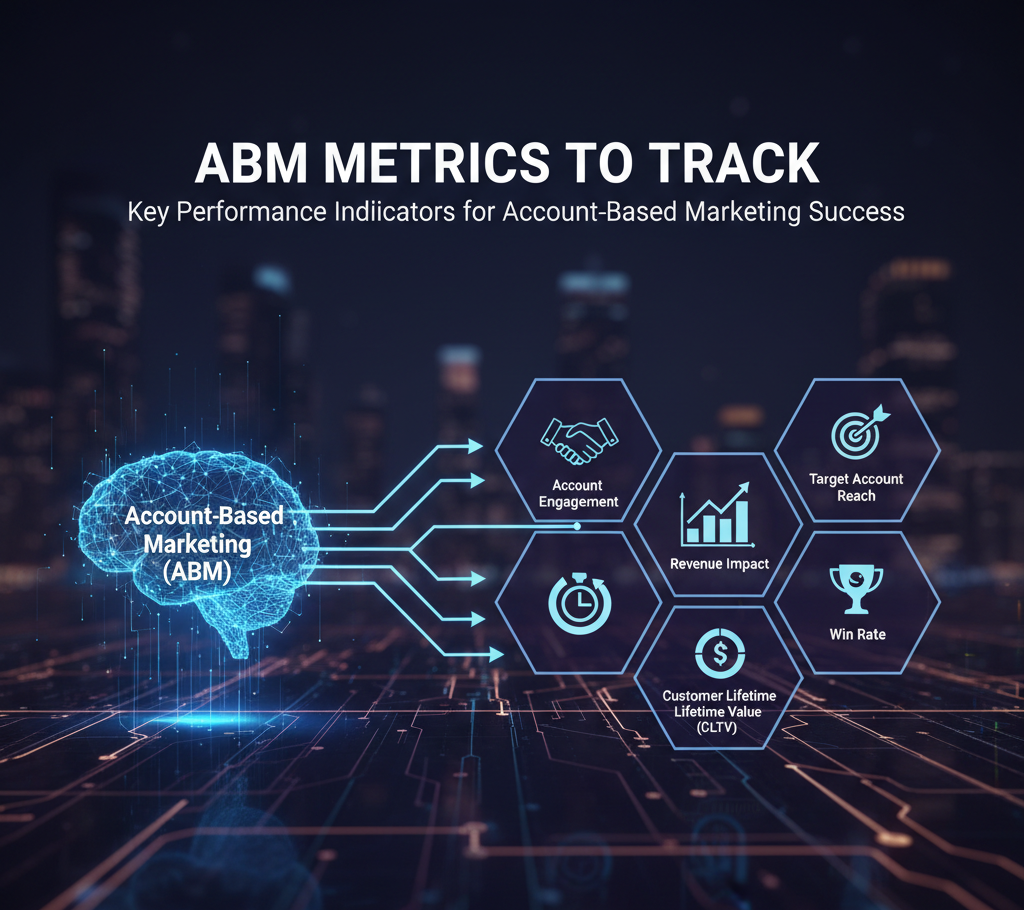Account-Based Marketing, or ABM, is a focused approach that targets high-value clients instead of chasing large audiences.
It allows sales and marketing teams to work together with precision, aiming at accounts that bring maximum business impact.
Tracking the right metrics ensures that every step of the process stays measurable and goal-driven.
What are ABM metrics?
ABM metrics are performance indicators used to measure how effectively an account-based marketing strategy is working.
They help identify which target accounts are engaging, how fast deals are moving, and how many are converting into loyal customers.
These metrics provide insights that guide decision-making, improve targeting, and prove the real value of ABM campaigns.
Why Tracking ABM Metrics Matters
ABM relies on data and performance measurement to stay effective.
Without tracking, it becomes difficult to know which accounts are engaging or moving closer to conversion.
Monitoring the right metrics ensures you focus resources on what works best, improve targeting, and maintain strong alignment between marketing and sales teams.
ABM Metrics to Track
Here are the key ABM metrics to track that help you measure engagement, deal progress, and overall campaign performance.
Monitoring these ensures your marketing and sales teams stay aligned toward high-value account conversions.
1. Account Engagement Score
This metric measures how actively target accounts interact with your marketing efforts, including website visits, ad clicks, content downloads, and email opens.
A high engagement score indicates strong interest and awareness, helping your team prioritize follow-ups.
Tracking engagement over time reveals which accounts are warming up and which need reactivation.
It also helps align marketing and sales teams by focusing on accounts showing the most intent.
Tools like HubSpot, Demandbase, or 6sense can automate engagement scoring and surface real-time insights.
Consistent monitoring ensures you’re not wasting effort on low-potential accounts and instead investing resources where relationships are growing stronger and closer to conversion.

2. Account Coverage
Account coverage reflects how well your marketing and sales efforts reach decision-makers within a target account.
In ABM, it’s not enough to target a single person; you need multiple stakeholders involved.
Tracking coverage helps ensure that your campaigns are reaching executives, managers, and influencers across departments.
Metrics like the number of contacts engaged, response rate from key roles, and touchpoint diversity show whether your outreach is comprehensive.
Strong coverage increases the chances of internal discussions about your brand and smoother sales processes later.
When gaps appear, it’s a sign to expand contact lists or adjust targeting to strengthen overall account penetration.
3. Pipeline Velocity
Pipeline velocity measures how fast opportunities move through your sales funnelfrom first contact to deal closure.
It combines factors like the number of qualified opportunities, win rate, and average deal size.
A slow pipeline might mean your ABM strategy isn’t effectively nurturing accounts or addressing objections.
Regularly tracking velocity highlights bottlenecks that delay conversions and shows which campaigns generate quicker movement.
Improving this metric often involves stronger personalization, better follow-up sequences, and tighter coordination between marketing and sales.
Faster pipeline velocity means a healthier flow of deals and more predictable revenue from targeted accounts.

4. Deal Size
Average deal size shows the revenue potential from each closed account.
ABM focuses on quality over quantity, so tracking deal size reveals whether your efforts are bringing in high-value clients.
If deal size remains small, it could mean your targeting needs refinement or you’re focusing on the wrong industries.
Monitoring this metric helps evaluate ROI and prioritize accounts with long-term value.
Comparing deal size before and after implementing ABM also measures campaign effectiveness.
Larger deal sizes usually indicate deeper trust, stronger relationships, and successful positioning of your brand as a premium solution provider within your niche.
5. Win Rate
Win rate calculates the percentage of deals won versus deals lost. It’s a clear indicator of how effective your ABM strategy is in converting target accounts into customers.
A rising win rate means your messaging, targeting, and follow-up strategies are aligned with account needs.
Conversely, a low rate signals miscommunication, poor lead qualification, or inadequate engagement.
Tracking win rates per campaign or segment offers deeper insights into what’s working and what’s not.
Improving this metric often comes from personalizing proposals, enhancing sales enablement, and focusing on accounts that show strong intent signals through prior engagement.

6. Customer Acquisition Cost (CAC)
Customer Acquisition Cost measures how much you spend to convert one account into a paying customer.
It includes ad spend, marketing tools, sales resources, and other related costs.
ABM typically has a higher CAC than traditional marketing, but it’s justified when targeting high-value clients.
Tracking CAC helps determine whether your campaigns are financially sustainable.
If CAC rises without corresponding deal growth, you may need to optimize ad targeting or reduce manual processes.
A healthy ABM strategy balances cost and return, ensuring each dollar spent brings measurable progress toward acquiring profitable, long-term clients.
7. Customer Lifetime Value (CLV)
Customer Lifetime Value estimates how much revenue a client will generate over the entire business relationship.
It’s a critical metric for ABM since the goal is not one-time sales but long-term partnerships.
A higher CLV means your strategy successfully nurtures loyalty and repeat business.
Comparing CLV to CAC shows whether your marketing investment is worthwhile.
To increase CLV, focus on ongoing engagement, account-based upselling, and delivering consistent post-sale support.
Regularly monitoring CLV helps identify your most profitable accounts and design retention campaigns that keep them connected with your brand for years.

8. Marketing Qualified Accounts (MQAs)
Marketing Qualified Accounts are those that show significant interest based on defined engagement criteria, such as multiple visits, downloads, or event participation.
Tracking MQAs helps your marketing team know which accounts are ready to hand over to sales.
This metric ensures alignment between departments and reduces wasted time on unready leads.
By analyzing what actions trigger MQA status, you can refine your nurturing process to move accounts faster down the funnel.
MQAs are an early sign of campaign effectiveness, showing how well your ABM content and offers are attracting and engaging the right audience.
9. Sales Qualified Accounts (SQAs)
Sales qualified accounts are those that marketing has identified as ready for direct sales outreach.
These accounts typically have budget authority, a clear need, and engagement that indicates strong buying intent.
Tracking SQAs ensures that sales teams focus on accounts most likely to convert.
Comparing SQAs to MQAs helps assess the quality of marketing leads and the efficiency of your qualification process.
A steady rise in SQAs suggests your ABM campaigns are successfully moving prospects toward decision stages.
Improving this metric often involves tighter marketing-sales collaboration and better intent data integration.

10. Account Retention Rate
Account retention rate measures how well you keep existing ABM clients over time.
In account-based marketing, retaining clients can be more valuable than acquiring new ones.
Tracking retention highlights customer satisfaction and the effectiveness of your relationship management.
A declining rate could signal service issues, lack of communication, or weak post-sale engagement.
Improving retention requires personalized follow-ups, tailored offers, and the continuous delivery of value.
When retention rates remain high, it demonstrates that your ABM strategy fosters trust and long-term loyalty, ultimately reducing churn and enhancing revenue stability for your business.
11. Expansion Revenue
Expansion revenue tracks income generated from upselling or cross-selling to existing accounts.
It’s a powerful ABM metric because it shows how well your brand continues to provide value after the initial sale.
High expansion revenue means your products or services are meeting client needs effectively.
Monitoring this metric helps identify satisfied customers who may be open to higher-tier solutions or complementary services.
If expansion revenue is low, it could mean missed opportunities for account growth.
Strategic nurturing, personalized offers, and proactive communication are key tactics for improving this metric and maximizing customer lifetime profitability.
12. Account Reach
Account reach measures how many contacts within each target account your campaigns have engaged.
ABM thrives on multi-person influence, not just single leads. If your reach is limited to a few individuals, decisions may stall.
Expanding reach ensures your brand is visible to key stakeholders and decision-makers.
This metric helps uncover whether your content and ads are being distributed effectively across a company.
Tools like LinkedIn Campaign Manager or ZoomInfo help visualize reach progress.
Your chances of conversion and more seamless deal negotiations increase with the number of people who are aware of your brand within an account.

13. Intent Data Score
Intent data shows how actively a target account is researching topics related to your solution.
Tracking this score helps prioritize high-interest accounts for timely outreach. A rising intent score signals buying readiness, while a declining one means interest is fading.
Integrating intent data into your ABM system helps your marketing team launch the right content and your sales team engage with stronger context.
Combining this with engagement metrics, you can predict which accounts are most likely to convert soon.
Regularly analyzing intent data ensures your strategy stays proactive rather than reactive.
14. ROI per Account
ROI per account measures the return generated from each targeted account compared to the cost of engaging it.
It’s the most direct indicator of ABM success. This metric shows whether your personalized campaigns are delivering profitable results or draining resources.
Tracking ROI per account helps identify which industries or audience segments bring higher returns, allowing smarter budget allocation.
When ROI varies significantly, review campaign channels, personalization depth, and sales interactions.
A consistent rise in ROI per account signals a mature, data-driven ABM program that’s effectively converting high-value targets into loyal customers.

How can Brandout help with ABM strategy?
Brandout helps businesses build and execute strong ABM (Account-Based Marketing) strategies through data-driven targeting, customized campaigns, and automation.
The team identifies high-value accounts using advanced analytics and then creates personalized content for each stage of the buyer journey.
Brandout also integrates CRM systems, runs paid ad campaigns, and tracks ABM metrics like engagement rate, conversion rate, and pipeline growth to measure performance accurately.
With Brandout’s expertise in digital marketing, businesses can align their sales and marketing teams, shorten sales cycles, and generate higher-quality leads that convert faster.
Conclusion
ABM metrics help you turn strategy into measurable outcomes.
Tracking engagement, conversion, pipeline speed, deal value, and retention provides a complete view of how effectively your campaigns are performing.
With regular analysis and improvement, these metrics help you target smarter, close faster, and build stronger relationships with your best-fit clients.
Measuring the right data ensures every move supports growth and long-term success.
FAQs
What is the most important metric in ABM?
Account engagement is often considered the key metric because it shows how well target accounts are responding to your campaigns and messages.
How often should ABM metrics be reviewed?
Metrics should be checked regularly, at least once a month, to identify performance trends and make quick improvements before campaigns lose impact.
Does ABM work for small businesses?
Yes, ABM can be highly effective for small businesses that focus on a limited number of valuable clients instead of broad, general audiences.
How can ABM improve sales and marketing alignment?
Tracking shared metrics ensures both teams work toward the same goals, making handovers smoother and improving lead quality and conversion rates.




